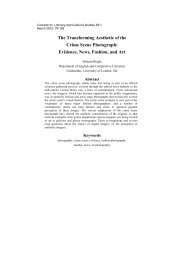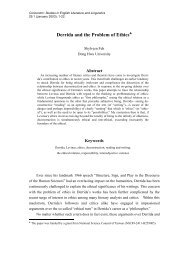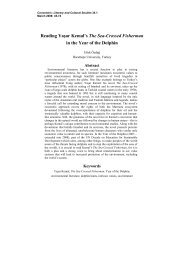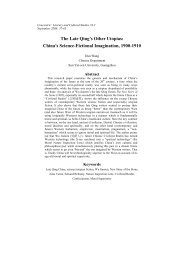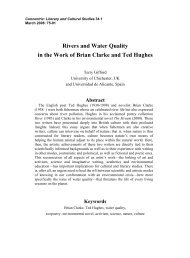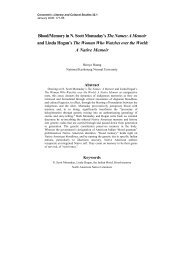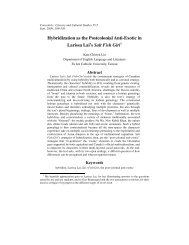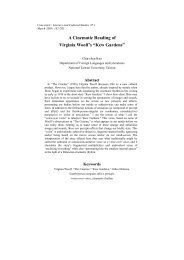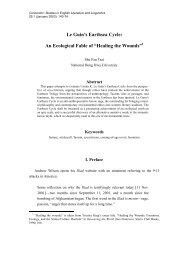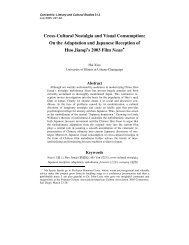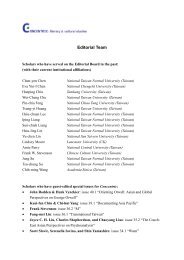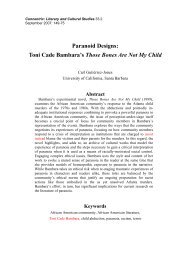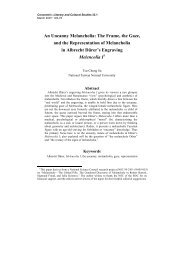“But the Greatest of These Is Love”: Desire for the ... - Concentric
“But the Greatest of These Is Love”: Desire for the ... - Concentric
“But the Greatest of These Is Love”: Desire for the ... - Concentric
- No tags were found...
You also want an ePaper? Increase the reach of your titles
YUMPU automatically turns print PDFs into web optimized ePapers that Google loves.
Tsai / <strong>“But</strong> <strong>the</strong> <strong>Greatest</strong> <strong>of</strong> <strong>These</strong> <strong>Is</strong> <strong>Love”</strong> 223Behind <strong>the</strong> entrepreneurship that upholds <strong>the</strong> dignity <strong>of</strong> <strong>the</strong> black community and<strong>the</strong> phantasmagoria <strong>of</strong> <strong>the</strong> resort resides an obscene underside harboring excessive,undue jouissance inherited from a “dark” fa<strong>the</strong>r. As Morrison points out in aninterview, “[t]here is a Dark in every community—maybe in every family”(Houston 234). To put it more precisely, <strong>the</strong>re is a Dark Fa<strong>the</strong>r lurking behind “BigDaddy” and threatening to undermine <strong>the</strong> authority this conceptual fa<strong>the</strong>r mayspeak <strong>for</strong>.With <strong>the</strong> chapter headings focusing on Cosey, Morrison leads <strong>the</strong> reader toponder on <strong>the</strong> problematized image <strong>of</strong> Cosey <strong>the</strong> character and that <strong>of</strong> <strong>the</strong> fa<strong>the</strong>r. All<strong>the</strong> female characters, inclusive <strong>of</strong> <strong>the</strong> non-Cosey women, are attached to BillCosey in one way or ano<strong>the</strong>r. To illustrate, in <strong>the</strong> first two chapters, respectivelyentitled “Portrait” and “Friend,” which are accounted mainly from Junior’s and <strong>the</strong>nfrom Vida’s vantage point, Cosey appears to be a handsome, munificent man, anidealized fa<strong>the</strong>r figure and <strong>the</strong> role model <strong>of</strong> <strong>the</strong> community. To illustrate, Vida, his<strong>for</strong>mer employee, used to look at him “with adoring eyes” and spoke <strong>of</strong> him “with<strong>for</strong>giving smiles” (40). In her eyes, Cosey is “royal” and <strong>the</strong> feud among <strong>the</strong> Coseywomen is warfare <strong>for</strong> “<strong>the</strong> prince’s smile” (37). Considering Cosey “a commanding,beautiful man surrendering to feuding women, letting <strong>the</strong>m ruin all he had built”(36), Vida blames <strong>the</strong> decline <strong>of</strong> his business on those women and even idealizeshim as “a saint” because <strong>of</strong> <strong>the</strong> jobs he provided <strong>for</strong> her and her husband Sandler.The most grotesque example <strong>of</strong> Cosey’s admirers is Junior, an eighteen-year-oldgirl hired by Heed decades after Bill Cosey’s death. At <strong>the</strong> first sight, she “falls inlove” with Cosey’s portrait, calls him her “Good Man” and searches <strong>for</strong> hispresence everywhere in <strong>the</strong> house. Along with <strong>the</strong> meandering development <strong>of</strong> <strong>the</strong>plot, a larger-than-life image <strong>of</strong> a black fa<strong>the</strong>r figure is collectively created through<strong>the</strong> reminiscence and interior monologues <strong>of</strong> <strong>the</strong> female characters until it isundermined by <strong>the</strong> exposition <strong>of</strong> more hidden truths. Apropos <strong>of</strong> this blackentrepreneur, Morrison states in an interview that through <strong>the</strong> things he does, sheintends to unfold “<strong>the</strong> idea <strong>of</strong> maleness,” what “everyone is looking <strong>for</strong> inmasculinity: that benevolent or hostile notion <strong>of</strong> maleness” (Houston 235). Whatshe actually unveils through this controversial character is more than this idea <strong>of</strong>masculinity—it is ra<strong>the</strong>r <strong>the</strong> different aspects <strong>of</strong> <strong>the</strong> fa<strong>the</strong>r that are scrutinized.As a fa<strong>the</strong>r and a grandfa<strong>the</strong>r, Bill Cosey should be able to assume <strong>the</strong> role asa stand-in <strong>of</strong> <strong>the</strong> symbolic fa<strong>the</strong>r, exerting <strong>the</strong> function <strong>of</strong> <strong>the</strong> Name(s) <strong>of</strong> <strong>the</strong> Fa<strong>the</strong>r 66 In Seminar XVII, Lacan indicates that <strong>the</strong> fa<strong>the</strong>r introduces to <strong>the</strong> child <strong>the</strong> master signifier,which “can be any signifier after all,” hence <strong>the</strong> Names <strong>of</strong> <strong>the</strong> Fa<strong>the</strong>r (Lacan 124; Verhaeghe 44).
224 <strong>Concentric</strong> 36.1 (March 2010): 217-241but he fails. Through this character, Morrison once again manifests <strong>the</strong> malfunction<strong>of</strong> this symbolic position in <strong>the</strong> African-American family, resulting from <strong>the</strong>“feminization” <strong>of</strong> black masculinity during <strong>the</strong> time <strong>of</strong> slavery. As Gallego indicates,“[t]he black notion <strong>of</strong> patriarchy personified by Cosey <strong>for</strong>ecloses any idea <strong>of</strong>kinship and community because . . . he miserably fails to foster a sense <strong>of</strong> familyand to guide and protect its members” (94). Yoo also remarks that due to racialdiscrimination, it is hard <strong>for</strong> a black man to occupy “<strong>the</strong> conceptual place <strong>of</strong> ‘<strong>the</strong>Fa<strong>the</strong>r’” (157). The “Dark” fa<strong>the</strong>r who embezzles jouissance figuratively impliesthis absence <strong>of</strong> <strong>the</strong> symbolic or conceptual Fa<strong>the</strong>r. Having learned about <strong>the</strong> source<strong>of</strong> Cosey’s <strong>for</strong>tune, Julia, Cosey’s wife, turns apa<strong>the</strong>tic and be<strong>for</strong>e she passes away,she cries <strong>for</strong> her fa<strong>the</strong>r instead <strong>of</strong> her husband. On <strong>the</strong> one hand, this implies thatJulia is psychologically in need <strong>of</strong> a fa<strong>the</strong>r as an authoritative figure in her life and,on <strong>the</strong> o<strong>the</strong>r hand, she has projected this figure onto her husband but <strong>the</strong> “dark”underside <strong>of</strong> this symbolic position disappoints her.Cosey, according to L, “transferred all <strong>of</strong> what he felt to his son” after his wifepasses away (100). L’s account <strong>of</strong> <strong>the</strong> relationship between <strong>the</strong> fa<strong>the</strong>r and <strong>the</strong> sonalso unfolds that it is <strong>the</strong> fa<strong>the</strong>r’s/O<strong>the</strong>r’s desire, not <strong>the</strong> mo<strong>the</strong>r’s, that <strong>the</strong> sonintends to meet—“[T]he boy had that insight smart children use with grown-ups inorder to stay important. Not by doing what <strong>the</strong>y say, but by figuring out what <strong>the</strong>yreally want” (emphasis added; 100). The son delights in being <strong>the</strong> fa<strong>the</strong>r’s“trophy”/phallus, 7 while <strong>the</strong> fa<strong>the</strong>r endeavors to turn his son into his own “shadow”(43). L reveals that after losing his only son, Cosey plans to get married againbecause he wants children “to fill <strong>the</strong> mirror <strong>for</strong> him <strong>the</strong> way Billy Boy used to”(emphasis added;104). Billy Boy marries May because his fa<strong>the</strong>r wants him “to weda devoted, not calculating, girl,” and May happens to be <strong>the</strong> kind <strong>of</strong> woman who“would nei<strong>the</strong>r disrupt nor rival <strong>the</strong> bond between fa<strong>the</strong>r and son” (102). Thisfa<strong>the</strong>r-son relationship is, to put in Lacan’s parlance, purely narcissistic and“imaginary”: <strong>the</strong> son is after <strong>the</strong> fa<strong>the</strong>r’s desire, pondering over <strong>the</strong> question “CheVuoi?”, while <strong>the</strong> fa<strong>the</strong>r makes <strong>the</strong> son his own mirror image; moreover, without <strong>the</strong>presence <strong>of</strong> <strong>the</strong> mo<strong>the</strong>r, Billy Boy satisfies himself with <strong>the</strong> role <strong>of</strong> “imaginaryphallus,” i.e. <strong>the</strong> signified <strong>of</strong> <strong>the</strong> desire <strong>of</strong> <strong>the</strong> mo<strong>the</strong>r supposed to be substituted by<strong>the</strong> Name <strong>of</strong> <strong>the</strong> Fa<strong>the</strong>r in <strong>the</strong> process <strong>of</strong> symbolization (Chiesa, Subjectivity 91).With his fa<strong>the</strong>r bragging about him in front <strong>of</strong> “yawning friends,” Billy Boy merely7 The phrase “trophy son” is used by <strong>the</strong> author herself in <strong>the</strong> interview with Houston, in whichMorrison describes Billy Boy as <strong>the</strong> son Bill Cosey “loved and bragged about, but loved in atrophy way” (234).
226 <strong>Concentric</strong> 36.1 (March 2010): 217-241chosen. Knowing she had no schooling, no abilities, no proper raising, he chose heranyway while everybody else thought she could be run over” (72-3). Heed evenromanticizes her premature marriage, claiming that her fa<strong>the</strong>r recognized “a trueromance” <strong>the</strong> moment he saw it (62). Wyatt points out that in <strong>the</strong> first eight chaptersHeed projects onto her life story <strong>the</strong> Cinderella story pattern, which is “a culturalmyth so fundamental to <strong>the</strong> ideology <strong>of</strong> social mobility that sustains capitalistculture” (208). Ensnared in this cultural myth, a collective social fantasy, shedepicts herself as a chosen poor girl whose “slippers” many women would like tobe in (61). However, in her version <strong>of</strong> <strong>the</strong> Cinderella story, <strong>the</strong> prince is a paternalfigure, called “Papa,” with whom she feels safe “no matter what he muttered in hissleep” but who also puts her across his knee and spanks her “with a kind <strong>of</strong>old-timey grace” (162, 126). The reader’s attention to Cosey’s marriage to a minor,along with <strong>the</strong> anxiety over his pedophilic inclination, is distracted by Heed’s“seductive language <strong>of</strong> romantic love” (Wyatt 208), her depiction <strong>of</strong> Cosey as asavior and <strong>the</strong> rivalry among <strong>the</strong> Cosey women. Heed’s side <strong>of</strong> story that hermarriage is “almost thirty years <strong>of</strong> perfect bliss” (62) is undermined by <strong>the</strong>narrator’s exposé that May’s and Christine’s hostility turns her married life intowarfare.In almost two thirds <strong>of</strong> <strong>the</strong> novel, <strong>the</strong> author makes explicit how <strong>the</strong> fantasy <strong>of</strong>a protective potent fa<strong>the</strong>r conducts <strong>the</strong> desire <strong>of</strong> <strong>the</strong> female characters. One <strong>of</strong> <strong>the</strong>things that irritate Christine is <strong>the</strong> image <strong>of</strong> her playmate, instead <strong>of</strong> herself, sittingin her grandfa<strong>the</strong>r’s lap. It is excruciating <strong>for</strong> her seeing her best friend with herown grandfa<strong>the</strong>r—as she reveals her annoyance to Junior, “One day we built castleson <strong>the</strong> beach; next day he sat her in his lap. One day we were playing house under aquilt; next day she slept in his bed. One day we played jacks; <strong>the</strong> next she wasfucking my grandfa<strong>the</strong>r. . . . One day this house was mine; next day she owned it”(131-2). The fa<strong>the</strong>r’s favor or desire also means a place at home, i.e. a place in <strong>the</strong>familial-symbolic structure dominated by <strong>the</strong> Fa<strong>the</strong>r. With <strong>the</strong> quarrels that occur onand <strong>of</strong>f after <strong>the</strong> wedding, what Christine resents most is <strong>the</strong> fact that it is hermo<strong>the</strong>r, a phallic mo<strong>the</strong>r catering to “<strong>the</strong> Big Man” in <strong>the</strong> house (133), who choosesto send her away from home. Having graduated from high school, Christine shows<strong>of</strong>f her knowledge <strong>of</strong> grammar to Heed and takes great delight in seeing hergrandfa<strong>the</strong>r take her side against Heed; her delight becomes “rampant as <strong>the</strong> three<strong>of</strong> <strong>the</strong>m—<strong>the</strong> real Coseys—left toge<strong>the</strong>r, drove <strong>of</strong>f in <strong>the</strong> big automobile, <strong>the</strong>unworthy one nowhere to be seen” (emphasis added; 134). The statement highlights<strong>the</strong> family name that signifies not only kinship but also a symbolic identity <strong>for</strong>medin <strong>the</strong> familial-symbolic system. This time, Heed is <strong>the</strong> one “nowhere to be seen.”
228 <strong>Concentric</strong> 36.1 (March 2010): 217-241her claim <strong>of</strong> blood was equal to Heed’s claim as widow. Or so she and Maythought” (79). It is conspicuous that <strong>the</strong> author implants an irony in this struggleover <strong>the</strong> “will” <strong>of</strong> <strong>the</strong> dead Fa<strong>the</strong>r: <strong>the</strong> will is <strong>for</strong>ged by a woman to save <strong>the</strong> o<strong>the</strong>rwomen from being thrown out on <strong>the</strong> street. Regardless <strong>of</strong> <strong>the</strong> deliberate ironicaltwist in this rendition, <strong>the</strong> episode still lays bare <strong>the</strong> fact that functioning like <strong>the</strong>name <strong>of</strong> <strong>the</strong> Fa<strong>the</strong>r, <strong>the</strong> will is a fiction fabricated in such a way as to <strong>for</strong>mulate <strong>the</strong>desire <strong>of</strong> <strong>the</strong> female subjects.Though remaining a bystander throughout <strong>the</strong> wrestling among <strong>the</strong> Coseywomen, even L herself harbors a romantic fantasy about this fa<strong>the</strong>r figure. Recalling<strong>the</strong> first time she saw Cosey at <strong>the</strong> age <strong>of</strong> five, L depicts a melodramatic scenario <strong>of</strong>romantic love:It’s noteworthy, I suppose, that <strong>the</strong> first time I saw Mr. Cosey,he was standing in <strong>the</strong> sea, holding Julia, his wife in his arms.I was five; he was twenty-four and I’d never seen anythinglike that. Her eyes were closed, head bobbing; her light blueswimming dress ballooned or flattened out depending on <strong>the</strong>waves and his strength. She lifted an arm, touched hisshoulder. He turned her to his chest and carried her ashore. Ibelieved <strong>the</strong>n it was <strong>the</strong> sunlight that brought those tears tomy eyes—not <strong>the</strong> sight <strong>of</strong> all that tenderness coming out <strong>of</strong><strong>the</strong> sea. (64)Given that L is only two years older than Billy Boy, this mnemonic imageundoubtedly is also a fantasmatic image <strong>of</strong> romantic love. Just as Heed romanticizesher relationship with her Papa, so L depicts <strong>the</strong> handsome man on <strong>the</strong> shore as anideal lover. In her reminiscence, L adds that nine years later, after Julia passes away,“when I heard he was looking <strong>for</strong> house help, I ran all <strong>the</strong> way to his door”(emphasis added; 65). It appears that when looking at <strong>the</strong> romantic scenario, Ldesires to be “in <strong>the</strong> picture.” Taking care <strong>of</strong> Billy Boy and cooking <strong>for</strong> Cosey <strong>for</strong>fifty years, L plays <strong>the</strong> role <strong>of</strong> housewife in <strong>the</strong> family; moreover, she reveals thatshe devotes all her attention to this man—“I pay attention and know all about him.That kind <strong>of</strong> understanding can only come from practice and I had a lot <strong>of</strong> that withMr. Cosey” (100). L’s account manifests that <strong>the</strong> fundamental fantasy <strong>for</strong>med at <strong>the</strong>beach sustains her desire <strong>for</strong> this fa<strong>the</strong>r figure <strong>for</strong> years and <strong>the</strong>re<strong>of</strong> makes <strong>the</strong> beachher favorite “setting” (105).
230 <strong>Concentric</strong> 36.1 (March 2010): 217-241The situation turns out to be repulsive when Junior starts to fantasize that “itpleased [Cosey <strong>the</strong> portrait] to see her taking care <strong>of</strong> his wife; as it pleased him towatch her and Romen wrestle naked in <strong>the</strong> backseat <strong>of</strong> his twenty-five-year-old car;just as it tickled him to know she was wearing his shorts” (124). She indulgesherself in living under <strong>the</strong> fa<strong>the</strong>rly gaze and becomes anxious when she does notsmell him or hear him: “She looked <strong>for</strong> him in <strong>the</strong> o<strong>the</strong>r rooms, because when shewas sitting in his study and wearing his tie, <strong>the</strong>re was no trace <strong>of</strong> aftershave; no‘Hey, sweet thing’ whispered in her ear” (130). This psychotic hallucination can beunderstood via a statement made by Verhaeghe regarding Lacan’s revision <strong>of</strong> <strong>the</strong>Oedipus Complex in his Seminar XVII; he argues that viewed from <strong>the</strong> level <strong>of</strong>discourse, since a woman is reduced to objet petit a, “she demands that <strong>the</strong> manassume an almighty position from which to be able to name her and provide herwith an identity <strong>of</strong> her own. Should she ever find such a man, The Man, she willfind psychosis” (46). It is after Romen licks her “merged toe,” a symbol <strong>of</strong> hertrauma, that <strong>the</strong> hallucination <strong>of</strong> <strong>the</strong> Good Man completely evaporates. The“lollipop lick” causes a jitter that makes her feel “wide open and whole” andhereafter lose interest in looking <strong>for</strong> her Good Man or sniffing out his aftershave.Be<strong>for</strong>e <strong>the</strong> “lollipop lick,” Junior “had suppressed suspicion <strong>of</strong> his betrayal”because <strong>the</strong> Good Man had been missing <strong>for</strong> a few days; after “<strong>the</strong> lollipop wastasted,” <strong>the</strong> Good Man “vanished from his painting altoge<strong>the</strong>r, leaving her giddyand alone with Romen” (196). The possessive power <strong>of</strong> <strong>the</strong> Fa<strong>the</strong>r gives way to <strong>the</strong>healing power <strong>of</strong> <strong>the</strong> “lollipop lick” <strong>of</strong> <strong>the</strong> lover.III. The Obscene, Real Fa<strong>the</strong>r <strong>of</strong> JouissanceThrough Junior, Morrison unfolds <strong>the</strong> real impossibility underlying <strong>the</strong>fantasy <strong>of</strong> “Good Man,” just as <strong>the</strong> void underlying <strong>the</strong> masculine fantasy <strong>of</strong> “TheWoman,” which, Lacan claims, does not exist. 9 Moreover, through Junior’s fantasyand <strong>the</strong>n her psychotic hallucination, Morrison manifests <strong>the</strong> eroticization <strong>of</strong> <strong>the</strong>longing <strong>for</strong> a fa<strong>the</strong>r, resulting from <strong>the</strong> evaporation <strong>of</strong> <strong>the</strong> familial structure. Alongwith <strong>the</strong> development <strong>of</strong> <strong>the</strong> meandering narration, <strong>the</strong> romanticization <strong>of</strong> Heed’smarriage with “Papa” and <strong>the</strong> idealization <strong>of</strong> <strong>the</strong> imaginary fa<strong>the</strong>r are bo<strong>the</strong>masculated by <strong>the</strong> gradual exposition <strong>of</strong> <strong>the</strong> traumatic scenes—<strong>the</strong> premature9 It is not only a fantasy that is involved. Lacan in his unpublished seminar Le Sinthomeindicates that <strong>the</strong> Woman is one <strong>of</strong> <strong>the</strong> names <strong>of</strong> <strong>the</strong> fa<strong>the</strong>r, referring to <strong>the</strong> enjoyment <strong>of</strong> <strong>the</strong> realfa<strong>the</strong>r, a situation which will be explored later in this section.
Tsai / <strong>“But</strong> <strong>the</strong> <strong>Greatest</strong> <strong>of</strong> <strong>These</strong> <strong>Is</strong> <strong>Love”</strong> 231encounter with sexuality. In so doing, <strong>the</strong> author also exposes <strong>the</strong> obscene underside<strong>of</strong> <strong>the</strong> symbolic fa<strong>the</strong>r—<strong>the</strong> real, anal fa<strong>the</strong>r <strong>of</strong> jouissance, who points to <strong>the</strong>pre-historical, Freudian primordial fa<strong>the</strong>r <strong>of</strong> <strong>the</strong> horde, <strong>the</strong> only man who possessesall women. Žižek clarifies <strong>the</strong> affinity between this primordial fa<strong>the</strong>r and <strong>the</strong>symbolic fa<strong>the</strong>r in Metastases <strong>of</strong> Enjoyment:On <strong>the</strong> one hand <strong>the</strong>re is <strong>the</strong> oedipal fa<strong>the</strong>r: <strong>the</strong> symbolic-dead fa<strong>the</strong>r,Name-<strong>of</strong>-<strong>the</strong>-Fa<strong>the</strong>r, <strong>the</strong> fa<strong>the</strong>r <strong>of</strong> Law who does not enjoy, whoignores <strong>the</strong> dimension <strong>of</strong> enjoyment; on <strong>the</strong> o<strong>the</strong>r hand <strong>the</strong>re is <strong>the</strong>“primordial” fa<strong>the</strong>r, <strong>the</strong> obscene, superego anal figure that isreal-alive, <strong>the</strong> “Master <strong>of</strong> Enjoyment. . . . [P]rimordial fa<strong>the</strong>r” is . . .<strong>the</strong> result <strong>of</strong> <strong>the</strong> dissolution <strong>of</strong> traditional symbolic authority. . . . Thesymbolic fa<strong>the</strong>r qua dead—that is ignorant <strong>of</strong> enjoyment—allows usto keep fantasies structuring our enjoyment at bay, to maintain aminimal distance between <strong>the</strong>m and <strong>the</strong> social space; whereas <strong>the</strong>obscene “anal” fa<strong>the</strong>r directly animates <strong>the</strong> phantasmatic support <strong>of</strong>our being which <strong>the</strong>reby immediately pervades <strong>the</strong> entire social field.(206)As Žižek points out, <strong>the</strong> appearance <strong>of</strong> <strong>the</strong> obscene, real fa<strong>the</strong>r results from <strong>the</strong>“dissolution” <strong>of</strong> <strong>the</strong> symbolic authority, which serves to keep fantasy at bay. Thatwhich is unveiled <strong>the</strong>reafter is a capricious master who is not bound by <strong>the</strong> law andwho “wants it all” (Zupančič 189). Bill Cosey’s incompetence as a stand-in <strong>for</strong>symbolic authority is underlined by his role as <strong>the</strong> capricious master who enjoysall—“He was <strong>the</strong> Big Man who, with no one to stop him, could get away with it andanything else he wanted” (133). Whe<strong>the</strong>r as a capitalist or a patriarch, he is <strong>the</strong> onewho “enjoys” regardless <strong>of</strong> <strong>the</strong> confinement <strong>of</strong> <strong>the</strong> Law. One <strong>of</strong> <strong>the</strong> hints <strong>the</strong> authorprovides is his secret deals with <strong>the</strong> white cops. A fa<strong>the</strong>r figure with “an avatar <strong>of</strong>libidinal excess and moral depravity” (Sathyaraj and Neelakantan 3), Cosey notonly presides over <strong>the</strong> family but simultaneously threatens to transgress <strong>the</strong> incesttaboo.The narrative structure reflecting <strong>the</strong> “delayed functioning <strong>of</strong> memory”bespeaks <strong>the</strong> presence <strong>of</strong> trauma (Wyatt 195). The fantasmatic scenarios portrayingan idealized munificent, protective and authoritative fa<strong>the</strong>r figure also serve to veil<strong>the</strong> traumatic encounter with <strong>the</strong> real, anal fa<strong>the</strong>r <strong>of</strong> jouissance. Heed’s completename “Heed <strong>the</strong> Night” actually <strong>for</strong>eshadows <strong>the</strong> threat <strong>of</strong> <strong>the</strong> looming “Dark”fa<strong>the</strong>r, i.e. <strong>the</strong> dark underside <strong>of</strong> <strong>the</strong> symbolic fa<strong>the</strong>r she and Christine must “heed.”
232 <strong>Concentric</strong> 36.1 (March 2010): 217-241L makes explicit this dark underside, albeit belatedly: “Whenever I see [BillCosey’s] righteous face correcting Heed, his extinguished eyes gazing at Christine, Ithink Dark won out” (emphasis added; 200). This Dark refers not only to DanielRobert Cosey but also implicitly to Bill Cosey’s “inside dirtiness” that isunspeakable and traumatic to both Heed and Christine (192).Resembling <strong>the</strong> fa<strong>the</strong>r <strong>of</strong> <strong>the</strong> primal horde, who does not subjugate himself toa transcendent law (Grigg 65), Cosey hovers around <strong>the</strong> borderline between <strong>the</strong> lawand <strong>the</strong> transgressive desire, tending to regard women around him as lovers(Gallego 94). Moreover, <strong>the</strong> fa<strong>the</strong>r-daughter relationship is even “eroticized” in animplicit way (Yoo 157). It is unveiled near <strong>the</strong> end <strong>of</strong> <strong>the</strong> novel that Heed’sromanticization <strong>of</strong> her relationship with Papa is actually a way to come to termswith <strong>the</strong> obscene fa<strong>the</strong>r. Be<strong>for</strong>e marrying Cosey, Heed has already traumaticallyconfronted adult sexuality, which is beyond her comprehension. Dressed inChristine’s swimming suit, she was sexually harassed by Cosey. What happened<strong>the</strong>n is accounted in <strong>the</strong> present tense to call attention to <strong>the</strong> endurance <strong>of</strong> thistraumatic memory:He touches her chin, and <strong>the</strong>n—casually, still smiling—her nipple. . . .Heed stands <strong>the</strong>re <strong>for</strong> what seems an hour but is less than <strong>the</strong> time ittakes to blow a perfect bubble. He watches <strong>the</strong> pink ease from hermouth, <strong>the</strong>n moves away still smiling. Heed bolts back down <strong>the</strong>stairs. The spot on her chest she didn’t know she had is burning,tingling. (191)This obscene “fa<strong>the</strong>r” gives an enigmatic smile that expresses <strong>the</strong> phallic jouissanceunknown to a prepubescent girl. The traumatic incidence <strong>the</strong>n changes her feelingabout her own body—a part <strong>of</strong> her body she didn’t know she had is now burningand tingling because <strong>of</strong> shame. Not until this revelation does <strong>the</strong> reader realize whyHeed takes a bath more than once a day and why she is worried about losing her“skin memory, <strong>the</strong> body’s recollection <strong>of</strong> pleasure” (77). The skin memory <strong>of</strong> herwedding night—“No penetration. No blood. No eeks <strong>of</strong> pain or discom<strong>for</strong>t. Just thisman stroking, nursing, bathing her” (77)—functions as a shelter against <strong>the</strong>traumatic shock and <strong>the</strong> memory traces it subsequently left on her body. That is, <strong>the</strong>later skin memory is a cover-up <strong>of</strong> <strong>the</strong> earlier traumatic skin memory. With <strong>the</strong>recollection <strong>of</strong> <strong>the</strong> powerful arms holding her in water, <strong>the</strong> bath is in fact a way tocleanse <strong>the</strong> earlier memory traces. Also related in <strong>the</strong> present tense, a similartraumatic shock hits Christine when, to find her playmate Heed, she looks up
Tsai / <strong>“But</strong> <strong>the</strong> <strong>Greatest</strong> <strong>of</strong> <strong>These</strong> <strong>Is</strong> <strong>Love”</strong> 233toward her bedroom window and sees her grandfa<strong>the</strong>r masturbating in her room.That night, <strong>the</strong> shadow <strong>of</strong> a real fa<strong>the</strong>r <strong>of</strong> jouissance hovers <strong>the</strong>re—“She didn’t haveto glance at <strong>the</strong> window or see <strong>the</strong> curtains yield be<strong>for</strong>e a breeze to know that an oldman’s solitary pleasure lurked <strong>the</strong>re” (emphasis added; 192). The abhorrent scenemakes her ashamed <strong>of</strong> her grandfa<strong>the</strong>r and <strong>of</strong> herself. The shame is hence<strong>for</strong>thdisplaced onto Heed as hatred. Not until <strong>the</strong>y articulate it do <strong>the</strong>y realize that <strong>the</strong>shame is actually “twin shames” (190). The shock is repressed and unable to be“symbolized,” not even in <strong>the</strong>ir secret language “idagay”: “[T]his particular shamewas different and could not tolerate speech—not even in <strong>the</strong> language <strong>the</strong>y hadinvented <strong>for</strong> secrets” (192). In Heed’s case, <strong>the</strong> fa<strong>the</strong>r <strong>of</strong> jouissance has to betrans<strong>for</strong>med into a beneficent, protective fa<strong>the</strong>r, a desire object <strong>for</strong> <strong>the</strong> femalecharacters.Morrison implicates <strong>the</strong> transgression <strong>of</strong> incest resulting from <strong>the</strong> failure <strong>of</strong><strong>the</strong> Law <strong>of</strong> <strong>the</strong> Fa<strong>the</strong>r and <strong>the</strong> consequent eroticization <strong>of</strong> <strong>the</strong> fa<strong>the</strong>r-daughterrelationship—it is hard not to notice that it is Christine’s swimming suit that Heedwears when <strong>the</strong> harassment happens, and it is also in Christine’s own room that <strong>the</strong>obnoxious scenario appears. This obscene, capricious fa<strong>the</strong>r lurks all along behinds<strong>the</strong> larger-than-life image <strong>of</strong> <strong>the</strong> Fa<strong>the</strong>r <strong>the</strong> female characters fantasize. Not until <strong>the</strong>end <strong>of</strong> <strong>the</strong> novel, be<strong>for</strong>e Heed’s death, do Christine and Heed ultimately come to <strong>the</strong>realization that <strong>the</strong> fa<strong>the</strong>r whose desire <strong>the</strong>y are obsessed with is also an obscenefa<strong>the</strong>r who stole <strong>the</strong>ir childhood. Moreover, in <strong>the</strong>ir reconciliatory, reminiscentconversation, <strong>the</strong> author has <strong>the</strong>m admit <strong>the</strong> fictitiousness <strong>of</strong> <strong>the</strong> fantasmatic BigDaddy:We could have been living our lives hand in hand instead <strong>of</strong> looking<strong>for</strong> Big Daddy everywhere.He was everywhere. And nowhere.We make him up?He made himself up.We must have helped. (189)The Big Daddy can be found everywhere, but since he is merely a fantasmaticconstruct, he is nowhere to be found. Morrison also suggests here that women havehelped make this Big Daddy up. In her interview with Silverblatt, Morrisonindicates that women in <strong>the</strong> novel are “complicit in that movement <strong>of</strong> constantlymaking [Cosey] <strong>the</strong> big daddy, <strong>the</strong> one who did it all” (emphasis added; 222).
234 <strong>Concentric</strong> 36.1 (March 2010): 217-241IV. “The <strong>Greatest</strong> Thing <strong>Is</strong> <strong>Love”</strong>—Agape vis-à-vis <strong>the</strong> <strong>Desire</strong> <strong>for</strong> <strong>the</strong> Fa<strong>the</strong>rIn Love, Morrison seems to make up <strong>the</strong> regret she leaves in Sula. As Houstonpoints out in <strong>the</strong> interview with <strong>the</strong> author, in Sula <strong>the</strong> two close friends Nell andSula never “reconnect,” whereas in Love, Christine and Heed do (230). Pin-chiaFeng argues that <strong>the</strong> latter can be regarded as “a belated sequel” to <strong>the</strong> <strong>for</strong>mer inview <strong>of</strong> <strong>the</strong> depiction <strong>of</strong> sisterhood (45). In this novel, <strong>the</strong> sisterhood is portrayedeven more like a state <strong>of</strong> pre-oedipal oneness.The intrusion <strong>of</strong> <strong>the</strong> fa<strong>the</strong>r—a twisted version <strong>of</strong> <strong>the</strong> Oedipalization—resultsin Christine’s and Heed’s premature entry into patriarchal libidinal economydominated by <strong>the</strong> phallus, or more precisely, <strong>the</strong> fa<strong>the</strong>r’s desire. As Wyatt remarks,even after Cosey’s death, Heed and Christine “remain preoccupied with <strong>the</strong>signifiers <strong>of</strong> capitalist patriarchy, with <strong>the</strong> terms that <strong>the</strong> Law <strong>of</strong> <strong>the</strong> Fa<strong>the</strong>r endowswith meaning: inheritance, property, legitimacy” (198). In addition, this paternalintervention, while severing <strong>the</strong>ir emotional tie, imposes on Christine and Heed <strong>the</strong>patriarchal logic <strong>of</strong> desire, rendering <strong>the</strong>m enthralled by <strong>the</strong> contest <strong>for</strong> <strong>the</strong> fa<strong>the</strong>r’sdesire. At <strong>the</strong> end <strong>of</strong> this novel, it dawns on <strong>the</strong>m, albeit too late, that it is not really<strong>the</strong> Fa<strong>the</strong>r <strong>the</strong>y desire; <strong>the</strong> endeavors <strong>the</strong>y have made indirectly aim at retrieving <strong>the</strong>childhood love which transcends <strong>the</strong> distinction <strong>of</strong> sex and class. That is, <strong>the</strong>traumatic encounter with <strong>the</strong> obscene fa<strong>the</strong>r and <strong>the</strong> patriarchal fantasy thatconducts <strong>the</strong>ir desire <strong>for</strong> <strong>the</strong> fa<strong>the</strong>r’s recognition distort <strong>the</strong>ir love <strong>for</strong> each o<strong>the</strong>r.The author subverts this patriarchal logic <strong>of</strong> desire by revealing <strong>the</strong>“pre-lapsarian” status <strong>of</strong> <strong>the</strong> affection between <strong>the</strong>se two girls. Heed thinksmarrying Cosey means getting closer to Christine, and what Christine has in mind isto stay with Heed even in her honeymoon. As one <strong>of</strong> <strong>the</strong>m says to <strong>the</strong> o<strong>the</strong>r, “[TheFa<strong>the</strong>r] took all <strong>of</strong> you away from me” (194). The kind <strong>of</strong> love <strong>the</strong>y have <strong>for</strong> eacho<strong>the</strong>r is, as L describes it, “a child’s first chosen love”:If such children find each o<strong>the</strong>r be<strong>for</strong>e <strong>the</strong>y know <strong>the</strong>ir own sex, orwhich one <strong>of</strong> <strong>the</strong>m is starving, which well fed; be<strong>for</strong>e <strong>the</strong>y know colorfrom no color, kin from stranger, <strong>the</strong>n <strong>the</strong>y have found a mix <strong>of</strong>surrender and mutiny <strong>the</strong>y can never live without. Heed and Christinefound each o<strong>the</strong>r. (italics original; 199)The absence <strong>of</strong> <strong>the</strong> mo<strong>the</strong>r causes <strong>the</strong> two girls to regard each o<strong>the</strong>r as <strong>the</strong>ir firstlove object; moreover, Morrison emphasizes <strong>the</strong> kind <strong>of</strong> love Christine and Heed
Tsai / <strong>“But</strong> <strong>the</strong> <strong>Greatest</strong> <strong>of</strong> <strong>These</strong> <strong>Is</strong> <strong>Love”</strong> 235have is a utopian state that has never been contaminated byOedipalization/symbolization because <strong>the</strong>ir first strong “passion” is pre-symbolicand thus pre-sexualized. Both girls lose a way to verbalize <strong>the</strong>ir love <strong>for</strong> each o<strong>the</strong>rbecause it is precluded from <strong>the</strong> soico-symbolic system governed by <strong>the</strong> Name <strong>of</strong><strong>the</strong> Fa<strong>the</strong>r and <strong>the</strong> signifier <strong>of</strong> <strong>the</strong> Fa<strong>the</strong>r’s desire.The “pre-lapsarian” state be<strong>for</strong>e <strong>the</strong> intrusion <strong>of</strong> adult sexuality is epitomizedby <strong>the</strong>ir secret language. Intrigued by a male voice saying, “Hey, Celestial,”conveying peculiar emotion that is beyond <strong>the</strong> comprehension <strong>of</strong> little girls, Heedand Christine imitate that voice whenever <strong>the</strong>y want to say “Amen” or to“acknowledge a particularly bold, smart, risky thing” (188); <strong>the</strong>y also invent <strong>the</strong>language “idagay” “<strong>for</strong> intimacy, gossip, telling jokes on grown-ups” (188). Thecode <strong>the</strong>y invent is more than <strong>the</strong> creation <strong>of</strong> <strong>the</strong>ir own “system <strong>of</strong> signification”(Burr 172); as a site where resistance may arise, this language de<strong>for</strong>ms <strong>the</strong> symbolicsystem by copying only <strong>the</strong> intonation <strong>of</strong> <strong>the</strong> voice “Hey, Celestial” withoutcarrying its original meaning, not to mention <strong>the</strong> derision it implies. Besides, thissecret language simulates <strong>the</strong> pre-lapsarian plenitude with <strong>the</strong> indecipherable andmeaningless suffix “idagay” functioning like <strong>the</strong> Lacanian lalangue, “maternaltongue,” which points to <strong>the</strong> non-phallic, O<strong>the</strong>r-jouissance that is beyond <strong>the</strong>symbolic domain. 10 “Hey, Celestial” and “idagay” are senseless to <strong>the</strong> girls but <strong>the</strong>yprovide surplus enjoyment. With <strong>the</strong> absence <strong>of</strong> mo<strong>the</strong>ring in this novel (O’Reilly175), <strong>the</strong> maternal, pre-symbolic relationship is replaced first by this verbal gameand <strong>the</strong>n by <strong>the</strong> merging <strong>of</strong> <strong>the</strong>ir identities in <strong>the</strong>ir last dialogues, which <strong>for</strong>m “anew narrative space in which past and present, childhood and age, coexist andunite” (Wyatt 210). The dissolution <strong>of</strong> <strong>the</strong> distinction between <strong>the</strong> speakers, asrevealed in <strong>the</strong> quote at <strong>the</strong> end <strong>of</strong> section III, and <strong>the</strong> abrupt evaporation <strong>of</strong> <strong>the</strong>third-person narrator, i.e. <strong>the</strong> absence <strong>of</strong> <strong>the</strong> third-term, manifests a symbioticcondition characteristic <strong>of</strong> <strong>the</strong> mo<strong>the</strong>r-child dyad.L is <strong>the</strong> only one who witnesses and acknowledges this first chosen-love. She“hums” her observation <strong>of</strong> <strong>the</strong> Cosey family and her comments on <strong>the</strong> charactersfrom a distance. Her first-person reminiscent narration makes <strong>the</strong> reader associateher name L with <strong>the</strong> title <strong>of</strong> <strong>the</strong> book. Throughout <strong>the</strong> narrative <strong>the</strong> letter L emergeson and <strong>of</strong>f like a floating signifier, <strong>the</strong> meaning <strong>of</strong> which is uncertain, and thisambiguity causes anxiety during <strong>the</strong> reading process until at <strong>the</strong> end she reveals that10 Lalangue is a term Lacan coins to refer to <strong>the</strong> infantile babbling that brings about jouissance(Evans 97). As Žižek defines it in How to Read Lacan, lalangue is “<strong>the</strong> space <strong>of</strong> illicit pleasurethat defy any normativity (71).
236 <strong>Concentric</strong> 36.1 (March 2010): 217-241her name is <strong>the</strong> subject <strong>of</strong> First Corinthians, chapter 13 (199). With this revelation,this floating signifier L seems to anchor its signified, love, but her voice turns out tobe more “disembodied” because it is one dissociated not only from <strong>the</strong> body <strong>of</strong> <strong>the</strong>speaker but also from time and space; as Wyatt points out, “[t]he signifier Love,because it is a title, floats free <strong>of</strong> context, available to any and all <strong>of</strong> a reader’sassociations to <strong>the</strong> word” (201). What floats free <strong>of</strong> context is not simply <strong>the</strong>signifier “<strong>Love”</strong> but also L’s voice since L turns out to be a ghost whose voice“floats free” out <strong>of</strong> its temporal and spatial context. This feature complicates <strong>the</strong>reading process. In <strong>the</strong> narrative, Cosey and L are two phantoms haunting <strong>the</strong> house;<strong>the</strong> <strong>for</strong>mer affects <strong>the</strong> female characters with his gaze, i.e. <strong>the</strong> portrait, and hisaftershave smell, while <strong>the</strong> latter asserts her presence with her humming voice and<strong>the</strong> smell <strong>of</strong> baking bread. It is her feminine voice and smell <strong>of</strong> nourishment thatexorcize <strong>the</strong> fa<strong>the</strong>rly and masculine gaze and smell “in <strong>the</strong> name <strong>of</strong> Love.”Being an ancestor-like figure (Ho 660), L plays a maternal role resemblingthat <strong>of</strong> Baby Suggs in Beloved or Connie in Paradise. As <strong>the</strong> cook <strong>of</strong> <strong>the</strong> hotel and<strong>the</strong> family, she is a nurturer like o<strong>the</strong>r maternal ancestral figures in previous novels.Her name seems to endow her with a keener insight than <strong>the</strong> o<strong>the</strong>rs’ to understandthat Heed and Christine are “<strong>the</strong> kind <strong>of</strong> children who can’t take back love, or parkit” and that when separation occurs to <strong>the</strong>m, it “cuts to <strong>the</strong> bone” (200). Besides, sheis also <strong>the</strong> first one who breaks away from <strong>the</strong> web <strong>of</strong> difference weaved by <strong>the</strong>phallus qua <strong>the</strong> signifier <strong>of</strong> desire and drops <strong>the</strong> question apropos <strong>of</strong> <strong>the</strong> Fa<strong>the</strong>r’sdesire. The author does not reveal lucidly why and how, yet L is apparently <strong>the</strong> onlywoman who harbors a romantic fantasy about this paternal figure but is able totraverse this fantasy, no longer seeing this Fa<strong>the</strong>r-O<strong>the</strong>r as <strong>the</strong> one who holds <strong>the</strong>answer to <strong>the</strong> question “Che Vuois?” Instead <strong>of</strong> regarding <strong>the</strong> O<strong>the</strong>r as completewith <strong>the</strong> answer to <strong>the</strong> meaning <strong>of</strong> <strong>the</strong> subject’s life, what she perceives in Cosey isa barred subject as she is: “You could call him a good bad man, or a bad goodman. . . . He was an ordinary man ripped, like <strong>the</strong> rest <strong>of</strong> us, by wrath and love”(200). In o<strong>the</strong>r words, even though she used to be infatuated with <strong>the</strong> romanticizedmasculinity and paternity Cosey represented at <strong>the</strong> beach, after long years working<strong>for</strong> him, what she sees in Cosey is not <strong>the</strong> idealized potent Fa<strong>the</strong>r but an ordinaryman who is also lacking. In Lacanian terms, L shows that which is characteristic <strong>of</strong>love, not <strong>of</strong> desire, since “love is always love <strong>for</strong> <strong>the</strong> O<strong>the</strong>r in so far as he islacking . . . because <strong>of</strong> his limitation” (Žižek, Did Somebody Say 57). In his reading<strong>of</strong> Lacan’s Seminar VIII, “‘Le Ressort de L’Amour,’” Chiesa also points out that
Tsai / <strong>“But</strong> <strong>the</strong> <strong>Greatest</strong> <strong>of</strong> <strong>These</strong> <strong>Is</strong> <strong>Love”</strong> 237“love relies on what <strong>the</strong> o<strong>the</strong>r lacks, and not on what he has” (emphasis original;68). 11 L poisons Cosey, a man she has cared about <strong>for</strong> more than fifty years, becauseshe finds that he plans to revise his will and bequeath nothing to <strong>the</strong> Cosey women.To <strong>for</strong>estall a tragedy, L murders <strong>the</strong> eighty-one-year-old “fa<strong>the</strong>r” and counterfeits<strong>the</strong> fa<strong>the</strong>r’s will, i.e. his desire, despite <strong>the</strong> fact that this counterfeit desire continuesto manipulate those women “in <strong>the</strong> name <strong>of</strong> <strong>the</strong> Fa<strong>the</strong>r.” Assuming that “ateighty-one he wasn’t going to get better’ (201), she chooses to sacrifice Cosey inorder to preserve a home <strong>for</strong> <strong>the</strong> three Cosey women. Though she cannot drive, Lkeeps Cosey’s ’55 convertible <strong>for</strong> herself in <strong>the</strong> will—probably just as an object toremember him by (88); this deliberation, however, may also be taken as a pro<strong>of</strong> <strong>of</strong>her affection <strong>for</strong> Cosey (Ho 656). There<strong>for</strong>e, in killing Cosey, she demolishes whatis very likely most precious to her; it is a feminine, ethical act in <strong>the</strong> Lacanian sense,which somehow resembles Se<strong>the</strong>’s, whereby, according to Žižek, <strong>the</strong> desperatemo<strong>the</strong>r shows her fidelity to <strong>the</strong> Thing by sacrificing also <strong>the</strong> Thing itself (FragileAbsolute, 154). L “sacrifices” <strong>the</strong> man she loves and serves <strong>for</strong> decades in her ownname, showing her fidelity to that which her name stands <strong>for</strong>—love.The deliberate allusion to First Corinthians Chapter 13 underlines <strong>the</strong>importance <strong>of</strong> love, <strong>“But</strong> <strong>the</strong> greatest <strong>of</strong> <strong>the</strong>se is love,” which L makes her business.Morrison contends that L’s love is generous love—“Jesus at his best” (Houston 233).Žižek, referring to <strong>the</strong> Lacanian logic <strong>of</strong> sexuation, <strong>the</strong> masculine all and femininenot-all, in his reading <strong>of</strong> First Corinthians Chapter 13, argues that in Paul’sdescription, agape “enjoins us to ‘unplug’ from <strong>the</strong> organic community into whichwe are born” and manifests an act <strong>of</strong> “clinging to an element that disturbs <strong>the</strong>balance <strong>of</strong> All” (Fragile Absolute 121). In contrast with <strong>the</strong> Pauline-Lacaniandialectic between <strong>the</strong> Law and desire which, founded on <strong>the</strong> logic <strong>of</strong> All and itsexception, is masculine and phallic, agape belongs to <strong>the</strong> realm <strong>of</strong> <strong>the</strong> femininebecause it makes even <strong>the</strong> All, or <strong>the</strong> complete knowledge, incomplete, i.e. not-All.Thus, in killing <strong>the</strong> Big Daddy, which amounts to renouncing her desire, L“unplugs” herself from <strong>the</strong> patriarchal socio-symbolic community she lives in anddisturbs its balance by swerving from <strong>the</strong> law <strong>of</strong> desire to <strong>the</strong> act <strong>of</strong> love. As Badiou,following Lacan, points out, <strong>the</strong>re is “dis-relation [dé-rapport]” between love anddesire (273). Figuratively speaking, <strong>the</strong> fa<strong>the</strong>r’s will stands <strong>for</strong> <strong>the</strong> object <strong>of</strong> desire,11 Chiesa in this paper also makes a distinction between real love and false love, <strong>the</strong> latter beingimaginary and narcissistic because <strong>the</strong> lover falls in love with his or her own ideal image (69, 71).L’s love is definitely not founded on <strong>the</strong> imaginary because she acknowledges <strong>the</strong> lack in Cosey.
238 <strong>Concentric</strong> 36.1 (March 2010): 217-241<strong>the</strong> stand-in <strong>of</strong> <strong>the</strong> objet a, which <strong>the</strong> Cosey women look <strong>for</strong>; if interpretedaccording to Lacan’s dictum <strong>of</strong> love in Seminar VIII—to love is “to give what onedoes not have” (Evans 103), L gives to Christine and Heed what she does not have,that which she works and lives <strong>for</strong> over <strong>the</strong>se fifty years—<strong>the</strong> epitome <strong>of</strong> <strong>the</strong> objet a,i.e. <strong>the</strong> fa<strong>the</strong>r’s house/favor <strong>for</strong> May, Christine and Heed. As <strong>for</strong> Christine and Heed,love returns when <strong>the</strong>y stop proving that <strong>the</strong>y are worthy <strong>of</strong> <strong>the</strong> fa<strong>the</strong>r’s love andwhen <strong>the</strong>y stop desiring to please <strong>the</strong> fantasized O<strong>the</strong>r as <strong>the</strong> one who knows wha<strong>the</strong> wants, i.e. when <strong>the</strong>y stop catering to <strong>the</strong> desire <strong>of</strong> that O<strong>the</strong>r.Near <strong>the</strong> end <strong>of</strong> her final monologue, L says that her <strong>for</strong>ged will givesChristine and Heed a reason to “stay connected” and to figure out how precious <strong>the</strong>“tongue” is (201). Probably referring to <strong>the</strong> secret language “idagay,” L indicatesthat <strong>the</strong> tongue can rescue women from <strong>the</strong> oppressive power or establishmentsymbolized by <strong>the</strong> “<strong>the</strong> attention <strong>of</strong> Police-heads hunting desperate women andhardheaded, misraised children” (201). As a<strong>for</strong>ementioned, <strong>the</strong> word “tongue”insinuates a linguistic system resisting <strong>the</strong> established symbolic edifice. However,<strong>the</strong> allusion to First Corinthians 13 inevitably brings to <strong>the</strong> reader’s mind <strong>the</strong>connection between <strong>the</strong> tongue and love indicated in verse one: “If I speak in <strong>the</strong>tongues <strong>of</strong> men and <strong>of</strong> angels, but have not love, I am only resounding gong or aclanging cymbal.” Morrison associates language with love as she comments on <strong>the</strong>women’s complicity in fabricating <strong>the</strong> big daddy: “[Christine and Heed are] at <strong>the</strong>point now where nothing but language can save <strong>the</strong>m. And that’s when you can sayL-O-V-E” (Silverblatt 222). The tongue can be used <strong>for</strong> accusation as is revealed byChristine’s hateful yelling meant to hurt Heed: “Ou-yidagay a ave-slidagay!E-hidagay ought-bidagay ou-yidagay ith-widagay a ear’s-yidagay ent-ridagayan-didagay a andy-cidagay ar-bidagay!” (“You a slave! He bought you with a year’srent and a candy bar!”), and <strong>the</strong> word “Ave-slidagay”(slave) “rang in [Heed’s] head”(emphasis added; 129). Without love, <strong>the</strong>ir “tongue” is none o<strong>the</strong>r than resoundinggong or a clanging cymbal. Only when <strong>the</strong>y are reconnected does <strong>the</strong> tongue thatexpresses love save <strong>the</strong>m. “Love never ends”; <strong>the</strong>re<strong>for</strong>e, at <strong>the</strong> very end <strong>of</strong> <strong>the</strong>narrative, Love “hums” on.Through Bill Cosey, Morrison represents <strong>the</strong> three different faces <strong>of</strong> <strong>the</strong> fa<strong>the</strong>r,a role an African-American man may have found difficult to deal with due to <strong>the</strong>trauma <strong>of</strong> slavery, which undermined masculinity and <strong>the</strong> symbolic position <strong>of</strong> <strong>the</strong>fa<strong>the</strong>r in an African-American family. In <strong>the</strong> novel, <strong>the</strong> fa<strong>the</strong>r who is supposed tooccupy <strong>the</strong> symbolic position has already been overshadowed by a “Dark,” realfa<strong>the</strong>r, who amassed illegitimate jouissance; meanwhile, <strong>the</strong> same fa<strong>the</strong>r isfantasized as <strong>the</strong> ideal paternal benefactor, who is able to “enjoy” <strong>the</strong> women
Tsai / <strong>“But</strong> <strong>the</strong> <strong>Greatest</strong> <strong>of</strong> <strong>These</strong> <strong>Is</strong> <strong>Love”</strong> 239around him when or/and because his desire enslaves <strong>the</strong>m. With her meanderingnarration, Morrison pr<strong>of</strong>fers a maneuver in almost all her oeuvres to cope with <strong>the</strong>symbolic system infiltrated with <strong>the</strong> desire <strong>of</strong> <strong>the</strong> (white) Fa<strong>the</strong>r; in this novel,through L’s monologue, she points to <strong>the</strong> “not-all” <strong>of</strong> <strong>the</strong> feminine as a means <strong>of</strong>salvation <strong>for</strong> women entrapped in <strong>the</strong> snare <strong>of</strong> <strong>the</strong> desire <strong>of</strong> <strong>the</strong> Fa<strong>the</strong>r-O<strong>the</strong>r andconsequently catering to this desire. Having traversed her own romantic fantasy <strong>for</strong>Bill Cosey, L sacrifices what she has never had, <strong>for</strong>ges <strong>the</strong> will <strong>of</strong> <strong>the</strong> Fa<strong>the</strong>r toserve her own purpose and saves Cosey’s women from being thrown out <strong>of</strong> <strong>the</strong>house. She is also <strong>the</strong> only one who is able to understand “<strong>the</strong> child’s first chosenlove,” a pre-symbolic and thus pre-sexualized sort <strong>of</strong> love that compensates <strong>for</strong> <strong>the</strong>absence <strong>of</strong> parental love. In so doing, Morrison renders <strong>the</strong> ghostlycharacter-narrator L an embodiment <strong>of</strong> agape, which makes <strong>the</strong> tongue no longer<strong>the</strong> sound <strong>of</strong> resounding gong or a clanging cymbal. “<strong>Love”</strong> goes on, Morrisonseems to imply, as L’s monologues transcend <strong>the</strong> confinement <strong>of</strong> temporality,“humming” <strong>the</strong> last word in <strong>the</strong> novel.Works CitedBadiou, Alain. “What <strong>Is</strong> Love?” Sexuation. Ed. Renata Salecl. Durham: Duke UP,2000. 263-81.Burr, Benjamin. “Mythopoetic Syncretism in Paradise and <strong>the</strong> Deconstruction <strong>of</strong>Hospitality in Love.” Toni Morrison and <strong>the</strong> Bible. Ed. Shirley A. Stave. NewYork: Peter Lang, 2006. 159-74.Chiesa, Lorenzo. “‘Le Ressort de L’Amour’: Lacan’s Theory <strong>of</strong> Love in HisReading <strong>of</strong> Plato’s Symposium.” Angelaki. 2.3 (2006): 6-80.___. Subjectivity and O<strong>the</strong>rness: A Philosophical Reading <strong>of</strong> Lacan. Cambridge:MIT Press, 2007.Evans, Dylan. An Introductory Dictionary <strong>of</strong> Lacanian Psychoanalysis. New York:Routledge, 1996.Feng, Pin-chia. “‘We was girls toge<strong>the</strong>r’: The Double Female Bildungsroman inToni Morrison’s Love.” Feminist Studies in English Literature 15.2 (2007):37-63.Gallego, Mar. “Love and <strong>the</strong> Survival <strong>of</strong> <strong>the</strong> Black Community.” The CambridgeCompanion to Toni Morrison. Ed. Justine Tally. Cambridge: Cambridge UP,2007. 92-100.Gauthier, M. The O<strong>the</strong>r Side <strong>of</strong> Paradise: Toni Morrison’s (Un)making <strong>of</strong> MythicHistory.” African American Review 39.3 (2005): 395-414.Grigg, Russell. “Beyond <strong>the</strong> Oedipus Complex.” Jacques Lacan and <strong>the</strong> O<strong>the</strong>r Side
240 <strong>Concentric</strong> 36.1 (March 2010): 217-241<strong>of</strong> Psychoanalysis. Durham: Duke UP, 2006. 50-68.Ho, Wen-ching. “‘I’ll Tell’—The Function and Meaning <strong>of</strong> L in Toni Morrison’sLove.” EurAmerica: A Special <strong>Is</strong>sue on Toni Morrison 36.4 (2006): 651-75.Houston, Pam. “Pam Houston Talks with Toni Morrison.” Toni Morrison:Conversations. Ed. Carolyn C. Denard. Jackson: UP <strong>of</strong> Mississippi, 2008.228-59.Lacan, Jacques. The O<strong>the</strong>r Side <strong>of</strong> Psychoanalysis: Seminar Book XVII. Trans.Russell Grigg. New York: Norton, 2007.Luepnitz, Deborah. “Beyond <strong>the</strong> Phallus: Lacan and Feminism.” The CambridgeCompanion to Lacan. Ed. Jean-Michel Rabaté. Cambridge: Cambridge UP,2003. 221-37Mbalia, Doreatha Drummond. Toni Morrison’s Developing Class Consciousness.2 nd ed. Selinsgrove: Susquehanna UP, 2004.Morrison, Toni. Love. New York: Vintage International, 2003.___. Forward. In Love. New York: Vintage International, 2005. ix-xii.O’Reilly, Andrea. Toni Morrison and Mo<strong>the</strong>rhood: A Politics <strong>of</strong> <strong>the</strong> Heart. Albany:State U <strong>of</strong> New York P, 2004.Roynon, Tessa. “A New ‘Romen’ Empire: Toni Morrison’s Love and <strong>the</strong> Classics.”Journal <strong>of</strong> American Studies 41.1 (2007): 31-47.Saur, Michael. “‘I Want to Write like a Good Jazz Musician’: Interview with ToniMorrison.” Toni Morrison: Conversations. Ed. Carolyn C. Denard. Jackson:UP <strong>of</strong> Mississippi, 2008. 224-7.Sathyaraj, V. and G. Neelakantan. “‘Dragon Daddies and False-Hearted Men’:Patriarchy in Toni Morrison’s Love.” Notes on Contemporary Literature 35.5(2005): 2-4.Siverblatt, Michael. “Michael Siverblatt Talks with Toni Morrison about Love.”Toni Morrison: Conversations. Ed. Carolyn C. Denard. Jackson: UP <strong>of</strong>Mississippi, 2008. 216-23.Sweeney, Megan. “‘Something Rogue’: Commensurability, Commodification,Crime, and Justice in Toni Morrison’s Later Fiction.” Modern Fiction Studies52.2 (2006): 440-69.Tsai, Chia-ching. “Historiography, Communal Identity and Feminine Jouissance—On Toni Morrison’s Paradise.” EurAmerica 38.2 (2008): 161-209.Verhaeghe, Paul. “Enjoyment and Impossibility: Lacan’s Revision <strong>of</strong> <strong>the</strong> OedipusComplex.” Jacques Lacan and <strong>the</strong> O<strong>the</strong>r Side <strong>of</strong> Psychoanalysis: Reflectionson Seminar XVII. Durham: Duke UP, 2006. 29-49.Wyatt, Jean. “Love’s Time and <strong>the</strong> Reader: Ethical Effects <strong>of</strong> Nachträglichkeit in
Tsai / <strong>“But</strong> <strong>the</strong> <strong>Greatest</strong> <strong>of</strong> <strong>These</strong> <strong>Is</strong> <strong>Love”</strong> 241Toni Morrison’s Love.” Narrative 16.2 (2008): 193-221.Yoo, JaeEun. “The Site <strong>of</strong> Murder: Textual Space and Ghost Narrator in ToniMorrison’s Love.” Space, Haunting, Discourse. Ed. Maria Holmgren Troy andElisabeth Wennı. Newcastle: Cambridge Scholars, 2008. 153-67.Žižek, Slavoj. Did Somebody Say Totalitarianism? Five Interventions in <strong>the</strong>(Mis)use <strong>of</strong> a Notion. New York: Verso, 2001.___. The Fragile Absolute or Why is <strong>the</strong> Christian Legacy Worth Fighting For?New York: Verso, 2000.___. Metastases <strong>of</strong> Enjoyment: Six Essays on Woman and Causality. New York:Verso, 1994.Zupančič, Alenka. Ethics <strong>of</strong> <strong>the</strong> Real: Kant, Lacan. New York: Verso, 2000.About <strong>the</strong> AuthorChia-chin Tsai ( 蔡 佳 瑾 ) is Associate Pr<strong>of</strong>essor in <strong>the</strong> Department <strong>of</strong> English Languageand Literature, Soochow University. Her research interests include post-feminism,psychoanalysis, postmodern fiction and ethnic literature. She has published severalscholarly articles on <strong>the</strong> novels <strong>of</strong> Angela Carter and Toni Morrison in Sun Yat-senJournal <strong>of</strong> Humanities ( 中 山 人 文 學 報 ), Review <strong>of</strong> English and American Literature ( 英 美文 學 評 論 ), Chung-wai Literary Monthly ( 中 外 文 學 ), NTU Studies in Language andLiterature and EurAmerica ( 歐 美 研 究 季 刊 ).Email: chinweit@ms17.hinet.net[Received 11 Sept. 2009; 28 Jan. 2010 accepted; revised 22 Feb. 2010]



